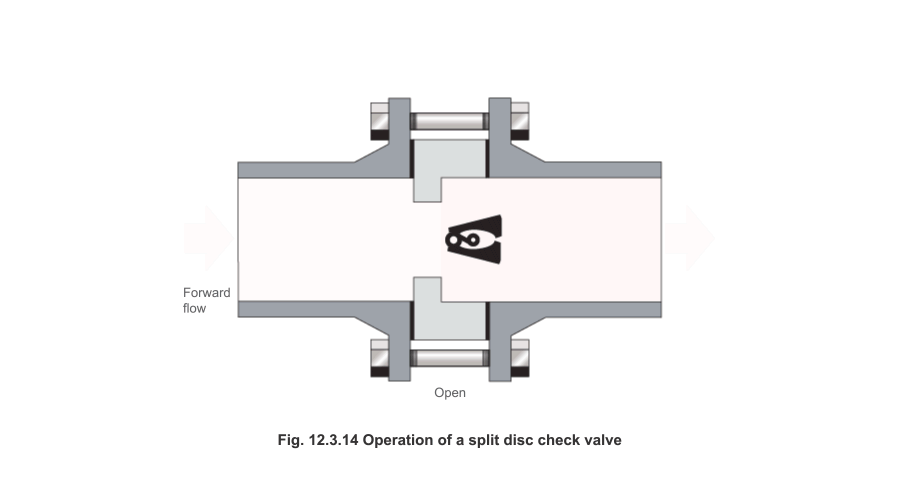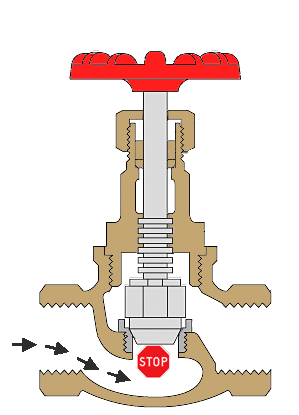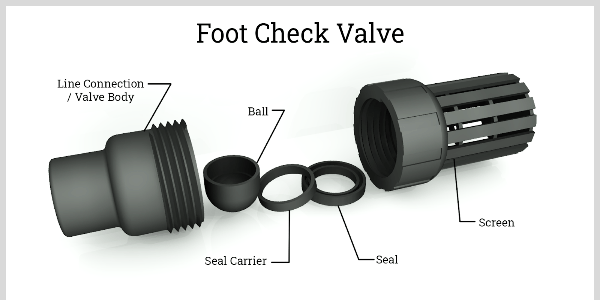A check valve is a type of valve which are designed to allow the flow of fluid in one directions by raising the disc by a pressure of fluid or it interrupt the flow in reverse direction by automatic lowering a disc.

Definition of valve is,it is a mechanical device which are designed to control or interrupt the flow of fluid in pipeline by lowering,raising or rotating a disc in a relation to a seating surface or by controlling the movement of a ball .So,The main function of valve is to control or interrupt the flow of fluid in pipeline.
It is done in check v/v by using lowering a disc.
1.Gate valve :- raising or lowering Disc Here disc is gate
2.Globe valve :-lowering or raising Disc
3.Ball valve :- Pivoted Ball
4.Butterfly valve :- Pivoted Disc
A check valve, is a non-return valve also known as reflux valve, retention valve, foot valve, or one-way valve.
Check valves are two-port valves, which means they have two openings in their bodies, one for fluid to enter and one for fluid to exit.Because they only allow media flow in one direction, check valves are also known as ‘one way valves’ or ‘non return valves.’ The main function of a check valve is to prevent backflow in the system.
Must read :- Centrifugal pump
What is a check valve used for ?
They are commonly installed in applications where backflow would cause a problem. However, because they are non-return valves, they are a cheap, effective, and simple solution to a potential problem. Backflow can be a problem if it is contaminated and thus contaminates the media upstream.
For example :-A non-return valve will be installed in a sewer line to ensure that waste can exit but not re-enter the system.
They are also used if backflow will cause damage to upstream equipment that can only allow media to flow in one direction. For example :-A reverse osmosis filter, can only allow water to pass through it in one direction, so a one-way valve is installed downstream to prevent this.
There are check valves of various sizes, designs, and materials to ensure that there is one for every application.
How does a check valve works ?
A check valve works on the pressure difference between inlet and outlet of the valve.To open the valve, they require a higher pressure on the input side than on the output side. When the pressure on the outlet side is too high (or the pressure on the input side is insufficient), the valve closes. The closure mechanism varies depending on the type of valve. Unlike other valves, they do not require a handle, lever, actuator, or human to function properly.
Working includes
A. Cracking pressure :-The check valve’cracking pressure’ is the minimum upstream pressure at which the valve opens.
The specific cracking pressure varies depending on the valve design and size, so make sure your system can generate this cracking pressure and that it is appropriate for the application.
B.Closing :-The valve will close if the upstream pressure falls below the cracking pressure or if there is back pressure (flow attempting to move from the outlet to the inlet). The closing mechanism of a check valve can vary depending on its design. Back pressure, in short, pushes a gate, ball, diaphragm, or disc against the orifice and seals it. The closing process can be aided by a spring or gravity, depending on the design.
C.Installation orientation :- As we know that it is one way valve so,it is very necessary to know about correct orientation of installation.Often, an arrow on the valve housing indicates the flow direction. Otherwise, you must inspect the valve to ensure that it is installed in the intended flow direction. If it is reversed, flow will be unable to move through the system, and a buildup of pressure may result in damage.
Advantages and Disadvantages of check valve
Advantages
1.protect pumps and compressor equipment from backflow and reverse flow damage
2.reduce downtime and production losses caused by the failure of unsuitable valves
3.A low pressure drop leads to greater energy savings.
4.Check valves are extremely effective at preventing water hammer.
5.reduce chatter and the possibility of sudden valve failure
6.reduced maintenance costs due to fewer moving parts
7.has a smaller footprint than traditional check valves
8.adaptability to changing flow conditions
9.interchangeability with most conventional swing check valves without the need for costly piping modifications
10.Do not require power to operate
Disadvantages
1.Do not operate in pulsating systems.
2.The closing element may slam shut, causing damage and wear.
3.Use a completely enclosed system.
4.Impossible to check if they are open or closed
5.Internal components cannot be inspected.
6.Disks can become stuck in the open state.
7.Noise from slamming disks
8.water hammer
9.Problems with reverse flow
Applications of check valve
Functions of check valve
1.To protect equipment downstream form backflow damage
2.To prevent contamination due to reverse flow
3.To prevent siphoning
4.To keep a vacuum seal
Due to their functions, They are used in almost every industry due to their function.
Domestic use :-They are commonly found in household appliances such as dishwashers, washing machines, and waste water lines.
In gardens, they control the flow of fertilizers and water in irrigation systems.
They are also commonly used as aquarium check valves on water and CO2 lines.
Industrial proces :- They are used in industrial applications such as boilers, furnaces, gas systems, pumping applications, and vacuum systems.
The aerospace and aircraft industries use check valves to control corrosive fluids, hydraulic systems, and the flow of fuel.
however other applications include:
● Process
● Mining
● Food & Beverage
● Oil & Gas
● Pharmaceutical
● Power
3.Pumps
The specific application of a check valve is determined by the component’s configuration. Lift and ball check valves, for example, must always be installed so that the lift is vertical. Swing check valves, on the other hand, must be installed to ensure that the disc is always closed freely and positively by gravity.
Check valve types
Different types of check valve are :-
Swing
Swing check valves are also known as ‘tilting-disc’ check valves. They are made up of a disc which is hinged (or trunnion) that swings open when an inlet pressure is applied. When the inlet pressure drops or there is backflow, the disc swings shut. If there is no spring to assist in closing, mounting orientation in relation to gravity is critical to ensure that the disc closes with gravity.

It is used in applications with a high solids content and a short on/off cycle.
Tilting
Tilting :-The pivot point of a tilting disk check valve is in the center of the disk, allowing fluid to flow over both the top and bottom of the disk. They are frequently used in areas where there is frequent flow reversal.

When the disk is open, the flow keeps it open, unlike a swing check valve, which is kept open by the velocity of the flow. The disk is small and light, with a center of gravity close to its pivot point. It has a low pressure drop at low flow rates and a higher pressure drop at high flow rates
Ball
A ball check valve employs a free-floating or spring-loaded ball that rests on the sealing seat to close the orifice. The sealing seat is typically conically tapered to guide the ball into the seat and create a positive seal, preventing reverse flow.

When the fluid pressure on the inlet side exceeds the cracking pressure, the ball is pushed out of its seat, allowing flow to occur. When the inlet pressure does not exceed the cracking pressure or there is back pressure, the ball will close with the back pressure or through the spring, effectively closing the orifice.
Diaphgram
In the pipeline, a flexible rubber diaphragm is placed in a mesh or perforated cone with the point pointing in the direction of flow (see Figure ). Flowing forward deflects the diaphragm inwards, allowing the fluid to pass freely.

When there is no flow or if there is backpressure, the diaphragm returns to its original position, closing the valve. The diaphragm material typically limits the diaphragm check valve’s application to fluids below 180°C and 16 bar.
Butterfly
A butterfly check valve is also known as a dual, folding disk, double disk, or splits check valve. They are made up of a butterfly, or wafer-style disc on a hinge and a spring.


When the inlet pressure exceeds the cracking pressure, as shown in Figure , the two sides open. When the inlet pressure drops or there is backflow, the hinge’s spring (or backpressure) closes the disc, effectively sealing it. This type of valve allows for a straight media flow with minimal obstruction.
Lift
A lift check valve is made up of a guided disc that rises (lifts) off the valve seat to allow media flow. These valves are similar in configuration to globe valves, except that the disc or plug is automatically operated.

It takes a cracking pressure to overcome gravity and/or a spring, and the guide keeps the disc in a vertical line so that it can be re-seated with proper alignment and seal. Lift check v/v typically require the media to turn 90 degrees, as shown in Figure , but there are lift check valves that are in-line or at an angle.

When the inlet pressure falls below the cracking pressure or there is backpressure, the valve will close due to gravity, spring, and/or backpressure. If there is no spring to assist in closing, mounting orientation in relation to gravity is critical to ensure that the disc closes with gravity.
Silent
Silent check valves, also known as poppet check valves, prevent water hammer or shock by closing before fluid flow reversal. The advantage of a silent check valve is that it closes quickly and smoothly, preventing damage to surrounding materials.
Stop
A stop check valve is a spring-loaded y-check valve or a lift check valve with a manual override feature. This allows them to function as a standard check valve and prevent backflow; however, an external mechanism can be used to override it and keep the valve open or closed.

As a result, this valve can act as two valves in one. They are frequently found in power plants, boiler circulation, steam generators, turbine cooling, and safety systems.
Duckbill
Duckbill valves allow flow to pass through a soft tube with a naturally flattened end. This flattened shape resembles a duck beak, hence the check valve’s name.

The flow allows fluid to pass through the flattened end of the duckbill. When the pressure on the inlet side is removed, the duckbill end returns to its flattened state, cutting off the flow.
Foot ball
A foot valve is simply a check valve with an inlet strainer that is installed at the end of a section of piping/hosing because their input does not have a connection point. In-line spring assisted or in-line ball check valves are common check valve types included in a foot valve; as a result, they only allow flow in one direction and are assisted in closing with a spring.

On the inlet side, a strainer prevents debris from entering the check valve and clogging or damaging something downstream. They are typically installed at the end of the suction line of a pump in a water well, fuel tank, or any other application where the suction line is located below the pump. As a result, they can be used to keep pumps primed, liquid from siphoning back, and debris out of the line. A foot valve is depicted in Figure.
Materials for check valve
Most check valves are made of durable materials that can withstand high pressures. Check valves are commonly made from PVC, CPVC, bronze, brass, iron, and stainless steel.
1.Brass :-Brass check valves are ideal for applications that involve the use of air, water, oil, or fuel. It is not, however, resistant to seawater, purified water, or chlorinated water. They are less resistant to heat and corrosion than stainless steel and are typically used in smaller, low-pressure applications.
2.Stainless steel :-Stainless check valves have excellent mechanical properties as well as superior corrosion resistance, heat resistance, and low-temperature resistance. When compared to PVC or brass check valves, stainless steel is typically not a cost-effective solution for applications that do not require high durability or resistance.
3.PVC :-Check valves made of PVC are commonly used in irrigation and water management systems. They are resistant to the majority of corrosive media, including seawater, acids, bases, chloride solutions, and organic solvents. They are not resistant to aromatic or chlorinated hydrocarbons, and their maximum temperature is typically around 60°C.
4.Polyproplene :-Check valves made of polypropylene are used for water, aggressive media, and liquid food products. They are resistant to most corrosive media, including inorganic acids, bases, and aqueous solutions, which corrode metals quickly. They are not, however, resistant to concentrated acids and oxidizing agents, and their maximum temperature is typically around 80°C.
5.Iron :-Iron is used in applications such as steam, water, oil, and gas. It can withstand a wide range of temperatures and pressures. Its high cost is offset by its excellent performance.
Selection criteria
When selecting a check valve for your application, keep the following criteria in mind:
1.Material compatibility with the medium
2.Line width for connection points
3.Maximum pressure and cracking pressure requirements
4.Horizontal or vertical installation
5.Envelope dimensions
6.Accessibility requirements for inspections and repairs
7.Temperature (external and media)
Check Out Other Important Topics
Home IC Engine Electrical Important PDFs Boilers Synergy Maritime Exam Naval Arch Interview Questions Difference Between Types of Pumps Types of Valves MEO Class 4 Auxiliary Machines
Source :-Tamesons
